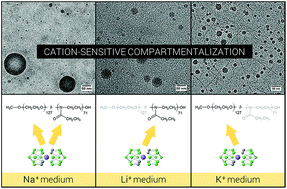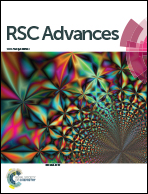Cation-sensitive compartmentalization in metallacarborane containing polymer nanoparticles†
Abstract
Alkaline cations (Li+, Na+ and K+) are introduced as agents suitable to control compartmentalization in metallacarborane-rich nanoparticles of double-hydrophilic block copolymer poly(ethylene oxide)-block-poly(2-alkyloxazoline), PEO–POX. Interaction of the metallacarborane (cobalt bis(dicarbollide) anion) with PEO–POX is based mainly on dihydrogen bonding between metallacarborane boron clusters and the polymer backbone resulting in compact nanoparticles. However, the cations are a crucial factor as to whether interaction with PEO or POX segments is preferred. Changes in the bulk concentration of alkaline cations can thus provoke changes in the inner structure of polymeric nanoparticles, which is accompanied by exchange of boron clusters and alkaline cations like Li+. Because of the biomedical importance of metallacarboranes, their conjugates and also lithium salts, the hybrid nanoparticles can act as stimuli-responsive systems for drug delivery.


 Please wait while we load your content...
Please wait while we load your content...